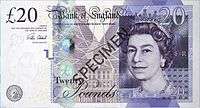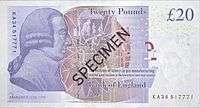Bank of England £20 note
| (United Kingdom) | |
|---|---|
| Value | £20 |
| Width | 149 mm |
| Height | 80 mm |
| Security features | Raised print, metallic thread, watermark, microlettering, UV feature, holographic strip, see-through register |
| Paper type | Cotton |
| Years of printing |
1725–1943; 1970–present 2007–present (current design) |
| Obverse | |
 | |
| Design | Queen Elizabeth II |
| Design date | 13 March 2007 |
| Reverse | |
 | |
| Design | Adam Smith |
| Design date | 13 March 2007 |
The Bank of England £20 note is a banknote of the pound sterling. It is the second highest denomination of banknote issued by the Bank of England. The current cotton note, first issued in 2007 bears the image of Queen Elizabeth II on the obverse and the image of Scottish economist Adam Smith on the reverse. Starting in 2020, the current note will be phased out, to be replaced by a polymer note featuring a portrait of J. M. W. Turner in place of Smith.
History
Twenty pound notes were introduced by the Bank of England for the first time in 1725. The earliest notes were handwritten, and were issued as needed to individuals. These notes were written on one side only and bore the name of the payee, the date, and the signature of the issuing cashier. With the exception of the Restriction Period between 1797 and 1821 when the French Revolutionary Wars and the Napoleonic Wars caused a bullion shortage these notes could be exchanged in full, or in part, for an equivalent amount of gold when presented at the bank. If redeemed in part, the banknote would be signed to indicate the amount that had been redeemed. From 1853 printed notes replaced handwritten notes, with the declaration "I promise to pay the bearer on demand the sum of twenty pounds" replacing the name of the payee. This declaration remains on Bank of England banknotes to this day. A printed signature of one of three cashiers appeared on the printed notes, though this was replaced by the signature of the Chief Cashier from 1870 onward.[1]

The ability to redeem banknotes for gold ceased in 1931 when Britain stopped using the gold standard.[1] The twenty pound note ceased to be produced by the Bank of England in 1943, and it was not until 1970 with the introduction of the series D notes that the denomination reappeared. The predominantly purple series D notes were two-sided, with an image of Queen Elizabeth II appearing on one side (all subsequent Bank of England notes also feature an image of the Queen) and an image of William Shakespeare appearing on the other. This note also had a security feature in the form of a 'windowed' metal thread. The thread is woven into the paper such that forms a dashed line, yet appears as a single line when held up to the light. Series D notes were phased out in favour of the newer series E notes beginning in 2000. These notes were multicoloured (predominantly mauve-purple) and featured an image of the scientist Michael Faraday on the back. Series E notes were replaced by a variant design from 1999 onwards. These are broadly similar to the earlier series E notes but feature Edward Elgar on the reverse.[2]
The current £20 note was introduced in 2007. It features a portrait of Scottish economist Adam Smith on the back as well as an illustration of workers in a pin factory.[3] The note features a number of security features in addition to the metallic thread including raised print, a watermark, microlettering, a holographic strip, a see-through register, and a colourful pattern which only appears under ultraviolet light.[4] In September 2015 the Bank of England announced that the next £20 note will be printed on polymer, rather than cotton paper.[5] This was followed by an announcement in April 2016 that Adam Smith will be replaced by artist J. M. W. Turner on the next £20 note which will enter circulation by 2020.[6] Images on the reverse of the Turner note will include a 1799 self-portrait of Turner, a version of Turner's The Fighting Temeraire, the quote "Light is therefore colour" from an 1818 lecture by Turner, and a copy of Turner's signature as made on his will.[7]
Designs
| Note | First issued | Last issued | Ceased to be legal tender | Colour | Size | Design | Additional information |
|---|---|---|---|---|---|---|---|
| White | 1725 | 1943 | 16 April 1945 | Monochrome (printed on one side only) | 211mm x 133mm (may vary) | Denomination discontinued until 1970 | |
| Series D | 9 July 1970 | 1991 | 19 March 1993 | Predominantly purple | 160mm x 90mm | Front: Queen Elizabeth II; Back: William Shakespeare | First £20 note to carry a portrait of a monarch and used a 'windowed' security thread (July 1984 onward) |
| Series E | 5 June 1991 | 2000 | 28 February 2001 | Multicoloured (predominantly mauve-purple) | 149mm x 80mm | Front: Queen Elizabeth II; Back: Michael Faraday | Those notes issued from September 1993 have an additional denomination symbol £20 on each side |
| Series E (variant) | 22 June 1999 | 2007 | 30 June 2010 | Multicoloured (predominantly mauve-purple) | 149mm x 80mm | Front: Queen Elizabeth II; Back: Edward Elgar | |
| Series F (paper) | 13 March 2007 | Multicoloured (predominantly mauve-purple) | 149mm x 80mm | Front: Queen Elizabeth II; Back: Adam Smith | |||
| Series F (polymer) | By 2020 | 139mm x 73mm | Front: Queen Elizabeth II; Back: J. M. W. Turner | ||||
Information taken from Bank of England website.[1][2]
See also
References
- 1 2 3 "A brief history of banknotes". Bank of England. Retrieved 28 April 2016.
- 1 2 "Withdrawn banknotes reference guide" (PDF). Bank of England. Retrieved 28 April 2016.
- ↑ "£20 Note (Adam Smith) – Design Features". Bank of England. Retrieved 28 April 2016.
- ↑ "£20 Note (Adam Smith) – Security Features". Bank of England. Retrieved 28 April 2016.
- ↑ "Paper banknotes disappearing fast as £20 turns plastic". BBC News. Retrieved 27 April 2016.
- ↑ "J.M.W. Turner to appear on the next £20 banknote". Bank of England. Retrieved 28 April 2016.
- ↑ "The next £20 note". Bank of England. Retrieved 28 April 2016.